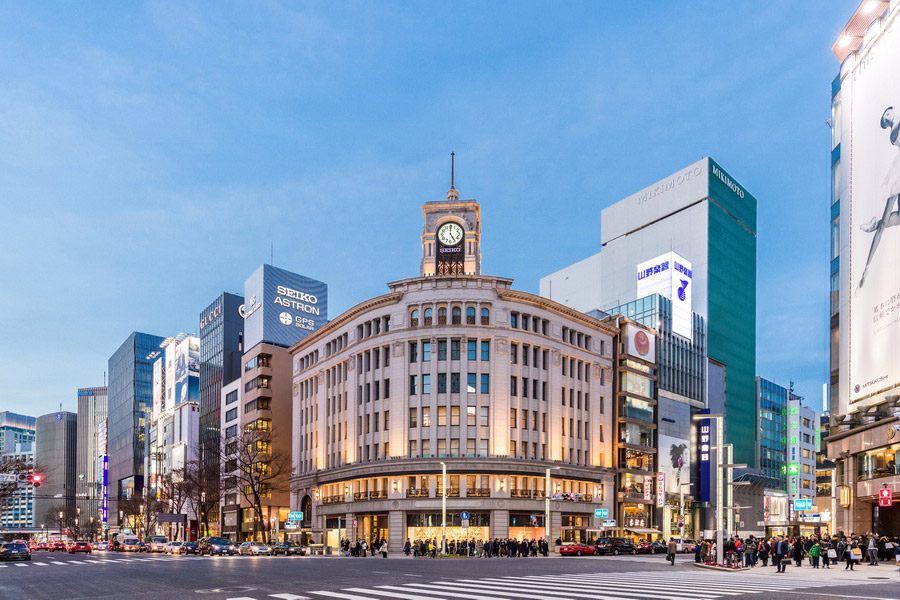
Ginza (銀座) is one of Tokyo's most famous and prestigious shopping districts, renown for its luxury shops, trendy boutiques, haute cuisine restaurants, and modern art galleries. It is the perfect place for visitors who want to experience the spirit of the metropolis and engage with Japanese culture at the intersection of tradition and modernity. Ginza is a must-see destination on your Tokyo itinerary, inviting you to immerse yourself into an atmosphere of wealth and elegance.
Find out what Ginza is famous for in our in-depth guide to Ginza. Is Ginza expensive? Which is the most famous street in Ginza?
Read the answers to these and other questions below. And if you want to know more about Japan, read our Japan Travel Guide.
How to Get to Ginza

Ginza is centrally located in Tokyo and is easily accessible from various parts of the city. The most convenient way to reach the area is by metro, with Ginza Station (銀座駅) being served by the Tokyo Metro Ginza Line (銀座線), Hibiya Line (日比谷線), and Marunouchi Line (丸ノ内線).
Additionally, Yurakucho Station (有楽町駅) on the JR Yamanote Line (山手線) is just a short walk away, providing further accessibility.
While buses and taxis are available, it's important to note that Tokyo's traffic can be heavy, especially during rush hours, which may affect travel times.
In summary, utilizing the metro system is the most efficient way to reach Ginza, ensuring quick and direct access to the district's main attractions.
History and Architecture
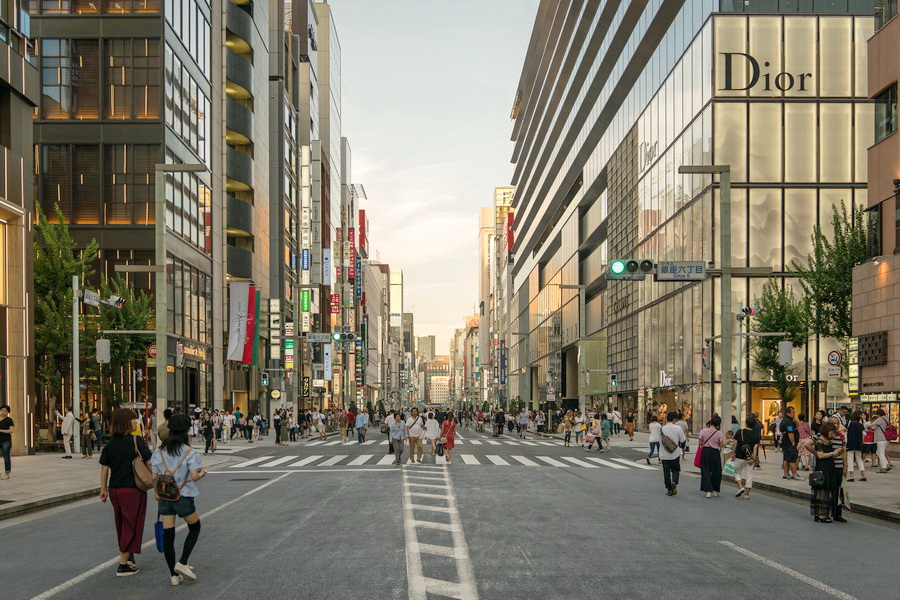
Ginza (銀座, ‘silver mint’) was named after a silver-coin mint that was located here in the 17th century. Over time, the area became an important centre of trade. In 1923, the great Kantō earthquake left Tokyo and the surrounding towns in ruins. Ginza gained its status as an elite shopping district after Tokyo was rebuilt. In the early 20th century, Ginza became the embodiment of Japan's modernisation: European-style brick buildings began to appear, in stark contrast to traditional Japanese architecture.
One of the symbols of this period was the second Seiko House clock tower shop, built in 1932. This neoclassical building with its elegant tower and clock is still one of Ginza's main attractions. It serves as a reminder of a time when Ginza was a place of bold architectural experimentation.
Today, Ginza is known for its unique architectural designs, including ultra-modern skyscrapers housing luxury brands. For example, the Hermes building designed by Renzo Piano features a glass facade made up of 13,000 bespoke, 450mm-square glass blocks. The play of light on the glass at different times of the day makes it one of Ginza's most recognisable architectural landmarks. Another stunning building is the Mikimoto edifice designed by Toyō Itō, which resembles a jewel. Its asymmetrical windows of various sizes and shapes create a light and dynamic effect that emphasises the brand's luxurious and avant-garde character.
One of the main features of Ginza's architecture is the bold use of modern technologies and materials. Here you can see buildings with innovative glass and steel facades that symbolise Tokyo's aspirations for the future. One square metre of land in the centre of the district costs over ten million yen (approximately 68,000 US dollars), making it one of the most expensive properties to buy in Japan.
Things to Do in Ginza
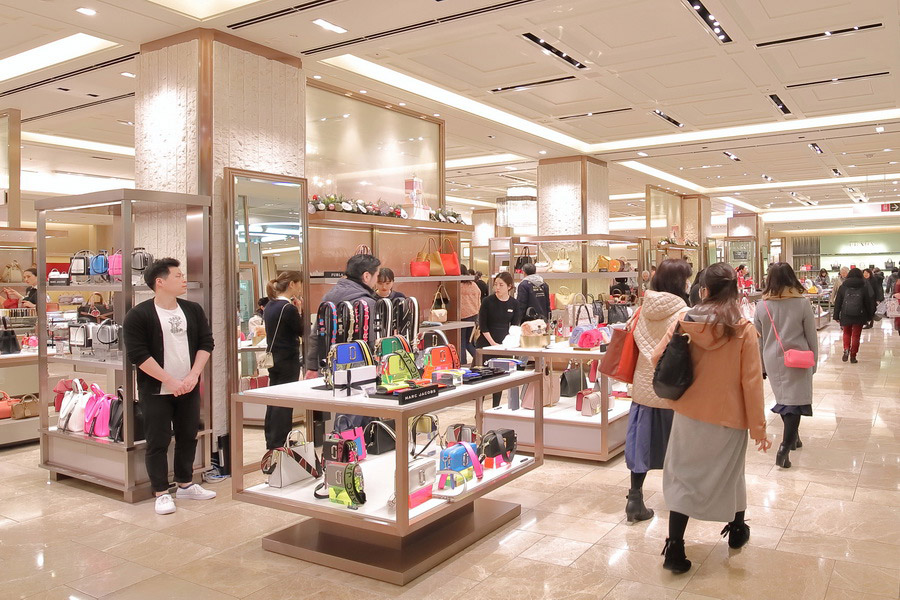
Discover Famous Fashion Brands
Ginza is a true shopping paradise. This area of Tokyo is considered one of the most prestigious and expensive shopping destinations in the world. It is home to flagship stores of global brands, Japanese designer boutiques, luxury department stores, and exclusive shops selling the rarest and most unique items. A stroll down the main street of Chuō-dori will take you into an atmosphere of luxury and elegance.
Cartier, Dior, and Bvlgari are among the well-known chic brands represented here. The streets of Ginza resemble a catwalk, showcasing the latest fashion trends. Flagship stores often feature exclusive collections that can only be found in the area, making shopping in Ginza particularly appealing to collectors and fashion enthusiasts.
Ginza Mitsukoshi Department Store
While exploring Ginza, don’t miss the historic Mitsukoshi Department Store - one of the largest and most modern shopping complexes in the area. It houses luxury brands such as Chanel, Louis Vuitton, Prada, and Gucci. In addition to foreign international designers labels, Ginza is also home to prestigious Japanese brands offering quality products such as Shiseido cosmetics and Issey Miyake clothing. The department store also has restaurants and even museums, providing a comprehensive shopping experience.
Uniqlo Ginza
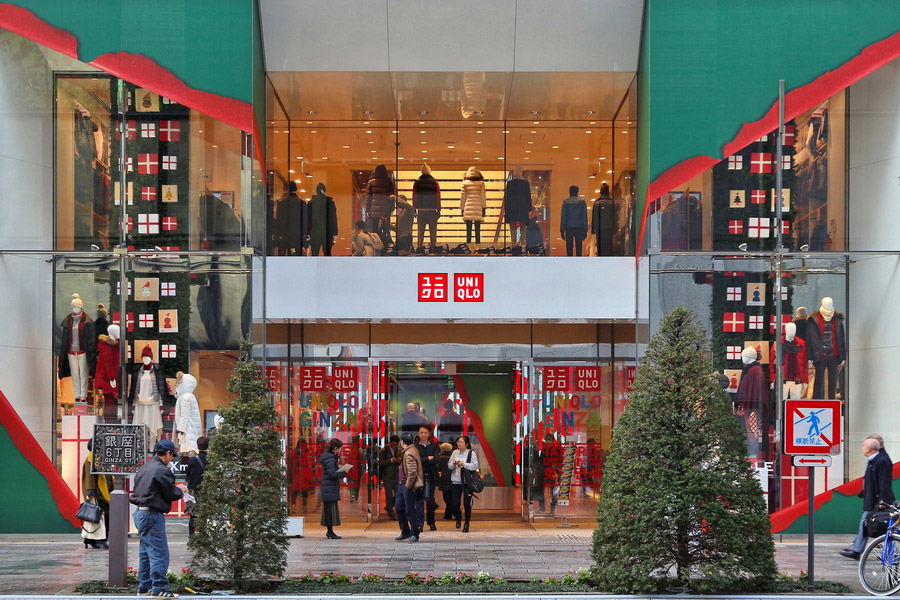
Uniqlo is not just a clothing store; it’s the flagship boutique of one of the world’s most popular Japanese brands. Uniqlo Ginza store is the largest of all Uniqlo stores in Japan and a true paradise for those who appreciate Japanese minimalism and practicality. Located on the main street of Chuō-dori, Uniqlo Ginza spans 12 floors, making it not only one of the brand's largest stores, but also a vibrant Ginza attraction.
Each floor of the store is dedicated to a distinct clothing category, ranging from basic models for everyday wear to special collections developed in collaboration with international designers. Uniqlo Ginza not only sells the brand's classic styles, but it also features limited-edition collections that are only available in the store, which makes it a must-visit even for those already familiar with Uniqlo's products.
Shopping Destinations
- Ginza Six (銀座シックス)
As the largest retail space in the district, Ginza Six houses over 200 stores, including flagship locations for brands like Fendi and Saint Laurent. The complex also features a rooftop garden and a Noh theater, blending luxury shopping with cultural experiences. - Mitsukoshi Ginza (三越銀座)
A historic department store offering a wide range of high-end fashion, cosmetics, and gourmet food selections. Its elegant atmosphere and exceptional service make it a must-visit destination. - Uniqlo Ginza (ユニクロ銀座店)
Spanning 12 floors, this flagship store provides an extensive selection of affordable, high-quality clothing, embodying the brand's minimalist aesthetic. - Ginza Itoya (銀座伊東屋)
A paradise for stationery enthusiasts, Itoya offers an impressive array of pens, notebooks, and crafting materials across its eight floors. - Hakuhinkan Toy Park (博品館トイパーク)
As one of Japan's largest toy stores, it features an extensive collection of toys and games, making it a delightful stop for families and collectors.
Indulge in Restaurants in Ginza

In addition to its excellent shopping, the Ginza district is renowned for its gastronomy. The area offers a wide range of restaurants, from traditional Japanese to the finest in European and Asian cuisine. Here you can indulge in world-class sushi, tempura, sashimi, and other Japanese dishes. Some restaurants boast Michelin stars, indicating a higher price, but many casual eateries serve delicious meals at more affordable prices.
One of the most famous restaurants in Ginza is Sukiyabashi Jiro, known for its exquisite sushi, which is personally prepared for each guest by the restaurant's owner, star Japanese chef Jiro Ono. Sukiyabashi Jiro was awarded three Michelin stars, the highest possible rating, although the stars were later removed - not because of a decline in the quality of the food or service, but because of the difficulty of booking a table. With only 10 seats available, it is almost impossible for an ordinary person to dine there. The restaurant has welcomed notable clients, including former US President Barack Obama, who described it as the best restaurant he had ever visited. Jiro Ono is now 98 years old and retired, but he still occasionally serves sushi with the help of his son, who has taken over the famous restaurant.
For visitors looking for something more affordable, Ginza is home to many cafes and small restaurants serving traditional dishes in cosy surroundings. Recommended spots include Yakiniku a Five Toku Ginza8chome, Kyubey Ginza Honten, Taishu Sukiyaki Hokuto Ginza Corridor, Kushiyaki Bistro Fukumimi Ginza, Gyuan Ginza, and IPPUDO Ginza. If you're still in the mood for a Michelin-starred meal, Tempura Kondo, with its two-star rating, is another excellent choice that's more easily accessible.
Dining Experiences
- Sukiyabashi Jiro (すきやばし次郎)
Renowned for its exceptional sushi, this establishment offers an intimate dining experience under the guidance of master chef Jiro Ono. - Gyoza Hohei (餃子歩兵 銀座)
A sister shop to its Kyoto-based counterpart, Gyoza Hohei is celebrated for its crispy dumplings with savory fillings, making it a perfect spot for a late-night bite. - Ginza Katsukami (銀座かつかみ)
Offering an elevated tonkatsu (breaded pork cutlet) experience, this restaurant presents an omakase-style menu, where the chef selects and prepares each course meticulously. - Ginza Hachigou (銀座八五)
A Michelin-starred ramen restaurant famed for its clear duck and chicken broth, offering a unique twist on traditional ramen dishes. - Ginza Sushiko Honten (銀座寿司幸本店)
With a history spanning over a century, this esteemed sushi restaurant offers a traditional Edomae sushi experience, highlighting the freshest seasonal ingredients.
Explore Attractions, Museums and Galleries
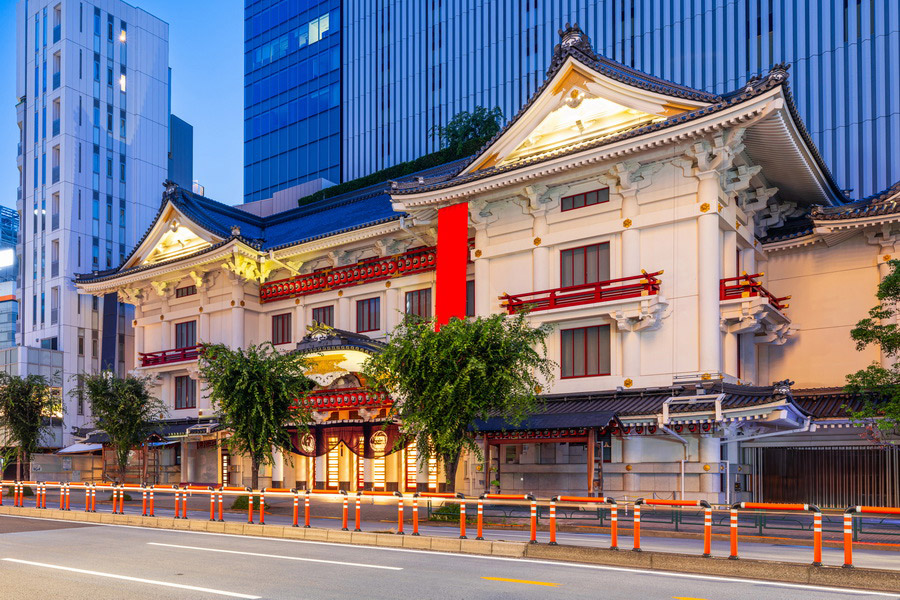
Ginza is not only about material wealth, but also rich in culture, with many museums and art galleries to explore. One of the district's main cultural venues is the Kabukiza Theatre, where visitors can experience traditional Japanese Kabuki performances. Founded in 1889, the theatre has a long history and is well-known for preserving ancient Japanese theatrical traditions.
In addition to the theatre, Ginza is home to many modern museums, such as the Art Aquarium Museum (Ginza), which takes visitors into a magical world where goldfish swim in beautifully lit aquariums, transforming them into living works of art.
Ginza is also full of galleries showcasing the work of Japanese and international artists. Notable galleries include Wako Works of Art and Shiseido Gallery, both of which regularly host contemporary art exhibitions.
Every Saturday and Sunday from noon to 5 PM., Ginza's main street is closed to traffic, allowing pedestrians to stroll freely. This event, known as Hokōsha Tengoku (歩行者天国) or Hokoten, which translates as "Pedestrian Paradise", features street performances such as magic shows and musical acts, adding to the vibrant atmosphere of the area.
Must-visit Cultural and Recreational Spots
- Kabuki-za Theater (歌舞伎座劇場)
The principal theater for traditional kabuki performances in Tokyo, offering visitors a chance to experience classical Japanese dance-drama in an iconic setting. - Ginza Sony Park (銀座ソニーパーク)
A public space that hosts a variety of events and exhibitions, providing an interactive experience that blends technology, art, and entertainment. - Chuō-dori Street (中央通り)
The main street of Ginza, lined with numerous shops and cafes. On weekends, it transforms into a pedestrian-only zone, allowing for leisurely exploration. - Shiseido Gallery (資生堂ギャラリー)
One of the oldest art galleries in Japan, showcasing contemporary art exhibitions and supporting emerging artists. - Hamarikyu Gardens (浜離宮恩賜庭園)
A tranquil Japanese garden located near Ginza, offering a serene escape from the bustling city with its beautifully landscaped grounds and traditional teahouse.
Tips for Visiting Ginza
- Opening Hours: Most shops and boutiques are open from 10 AM. to 8 PM.
- Best Time to Visit: The evening hours are the most beautiful, as the streets of Ginza come alive with neon lights, creating a unique nighttime atmosphere.
- Dress Code: Ginza, particularly in upscale restaurants and boutiques, often has a dress code. While casual attire is generally acceptable for travellers, more formal wear may be required in luxury restaurants or during specific events.
- Planning Ahead: Given the popularity of the location, it's a good idea to reserve restaurant tables and tickets for performances well in advance, especially for the more exclusive venues.
- Budget Considerations: As a luxury area, prices in Ginza can be significantly higher than average. If you're on a budget, it's a good idea to look for more affordable cafes and shops in the area.
- Tax-Free Refund: Like other department stores, Ginza offers tax refunds for international travellers.
Ginza represents the best of modern Tokyo. This elegant district is a symbol of metropolitan life in Japan and offers an unforgettable experience for every tourist. Whether you want to explore the world of fashion, indulge in Japanese cuisine, or discover contemporary art, Ginza promises a unique experience that is truly one of a kind.

